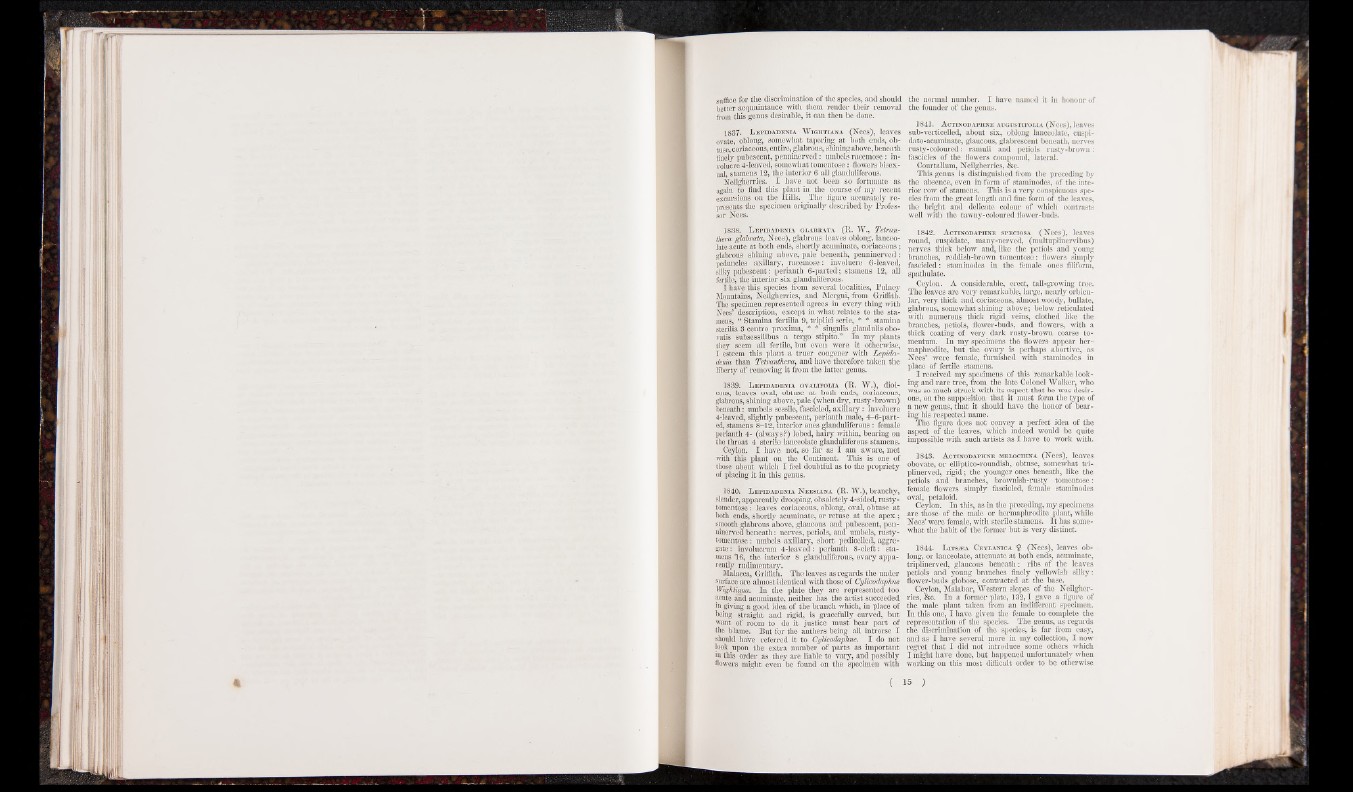
suffice for the discrimination of the species, and should
better acquaintance with them render their removal
fi-om this genus desirable, it can then be done.
1837. L epedadenia W ightiana (Nees), leaves
ovate, oblong, somewhat tapering at both ends, obtuse,
coriaceous, entire, glabrous, shining above, beneath
finely pubescent, penninerved: umbels racemose: involucre
4-leaved, somewhat tomentose: flowers bisexual,
stamens 12, the interior 6 all glanduliferous.
Neilgherries. I have not been so fortunate as
again to find this plant in the course of my recent
excursions on the Hills. The figure accurately represents
the specimen originally described by Professor
Nees.
1838. L epedadenia glabrata (R. W., Tetran-
thera glabrata, Nees), glabrous leaves oblong, lanceolate
acute at both ends, shortly acuminate, coriaceous;
glabrous shining above, pale beneath, penninerved:
peduncles axillary, racemose: involucre 6-leaved,
silky pubescent: perianth 6-parted; stamens 12, all
fertile, the interior six glanduliferous.
I have this species from several localities, Pulney
Mountains, Neilgherries, and Mergui, from Griffith.
The specimen represented agrees in every thing with
Nees’ description, except in what relates to the stamens,
“ Stamina fertilia 9, triplici serie, * * stamina
sterilia 3 centro proxima, * * singulis glandulis obo-
vatis subsessilibus a tergo stipita.” In my plants
they seem all fertile, but even were it otherwise,
I esteem this plant a truer congener with Lepida-
denia than Tetranthera, and have therefore taken the
liberty of removing it from the latter genus.
1839. L epedadenia ovaxifolia (R. W.), dioi-
cous, leaves oval, obtuse at both ends, coriaceous,
glabrous, shining above, pale (when dry, rusty-brown)
beneath: umbels sessile, fascicled, axillary: involucre
4-leaved, slightly pubescent, perianth male, 4-6-part-
ed, stamens 8-12, interior ones glanduliferous: female
perianth 4- (always?) lobed, hairy within, bearing on
the throat 4 sterile lanceolate glanduliferous stamens.
Ceylon. I have not, so far as I am aware, met
with this plant on the Continent. This is one of
those about which I feel doubtful as to the propriety
of placing it in this genus.
1840. Lepidadenia N eesiana (R. W .), branchy,
slender, apparently drooping, obsoletely 4-sided, rusty-
tomentose: leaves coriaceous, oblong, oval, obtuse at
both ends, shortly acuminate, or retuse at the apex;
smooth glabrous above, glaucous and pubescent, pen-
ninerved beneath: nerves, petiols, and umbels, rusty-
tomentose: umbels axillary, short pedicelled, aggregate
: involucrum 4-leaved: perianth 8-cleft: stamens
16, the interior 8 glanduliferous, ovary apparently
rudimentary.
Malacca, Griffith. The leaves as regards the under
surface are almost identical with those of Cylicodaphne
Wightiana. In the plate they are represented too
acute and acuminate, neither has the artist succeeded,
in giving a good idea of the branch which, in place of
being straight and rigid, is gracefully curved, but
want of room to do it justice must bear part of
the blame. But for the anthers being all introrse I
should have referred it to Cylicodaphne. I do not
look upon the extra number of parts as important
in this order as they are liable to vary, and possibly
flowers might even be found on the specimen with
the normal number. I have named it in honour of
the founder of the genus.
1841. Actinodaphne augustefolia (Nees), leaves
sub-verticelled, about six, oblong lanceolate, cuspi-
dato-acuminate, glaucous, glabrescent beneath, nerves
rusty-coloured: ramuli and petiols rusty-brown :
fascicles of the flowers compound, lateral.
Courtallum, Neilgherries, «c.
This genus is distinguished from the preceding by
the absence, even in form of staminodes, of the interior
row of stamens. This is a veiy conspicuous species
from the great length and fine form of the leaves,
the bright and delicate colour of which contrasts
well with the tawny-coloured flower-buds.
1842. Actinodaphne speciosa (Nees), leaves
round, cuspidate, many-nerved, (multuplinervibus)
nerves thick below and, like the petiols and young
branches, reddish-brown tomentose: flowers simply
fascicled: staminodes in the female ones filiform,
spathulate.
Ceylon. A considerable, erect, tall-growing tree.
The leaves are very remarkable, large, nearly orbicular,
very thick and coriaceous, almost woody, bullate,
glabrous, somewhat shining above; below reticulated
with numerous thick rigid veins, clothed like the
branches, petiols, flower-buds, and flowers, with a
thick coating of very dark rusty-brown coarse to-
mentum. In my specimens the flowers- appear hermaphrodite,
but the ovary is perhaps abortive, as
Nees’ were female, furnished with staminodes in
place of fertile stamens.
I received my specimens of this remarkable looking
and rare tree, from the late Colonel Walker, who
was so much struck with its aspect that he was desirous,
on the supposition that it must form the type of
a new genus, that it should have the honor of bearing
his respected name.
The figure does not convey a perfect idea of the
aspect of the leaves, which indeed would be quite
impossible with such artists as I have to work with.
1843. Actinodaphne melochina (Nees), leaves
obovate, or elliptico-roundish,. obtuse, somewhat tri-
pUnerved, rigid; the younger ones beneath, like the
petiols and branches, brownish-rusty tomentose:
female flowers simply fascicled, female staminodes
oval, petaioid.
Ceylon. In this, as in the preceding, my specimens
are those of the male or hermaphrodite plant, while
Nees’ were female, with sterile stamens. I t has somewhat
the habit of the former but is very distinct.
1844. Litsjea Ceylanica $ (Nees), leaves oblong,
or lanceolate, attenuate at both ends, acuminate,
triplinerved, glaucous beneath: ribs of the leaves
petiols and young branches finely yellowish silky:
flower-buds globose, contracted at the base.
Ceylon, Malabar, Western slopes of the Neilgherries,
&c. In a former plate, 132,1 gave a figure of
the male plant taken from an indifferent specimen.
In this one, I have given the female to complete the
representation of the species. The genus, as regards
the discrimination of the species, is far from easy,
and as I have several more in my collection, I now
regret that I did not introduce some others which
I might have done, but happened unfortunately when
working on this most difficult order to be otherwise